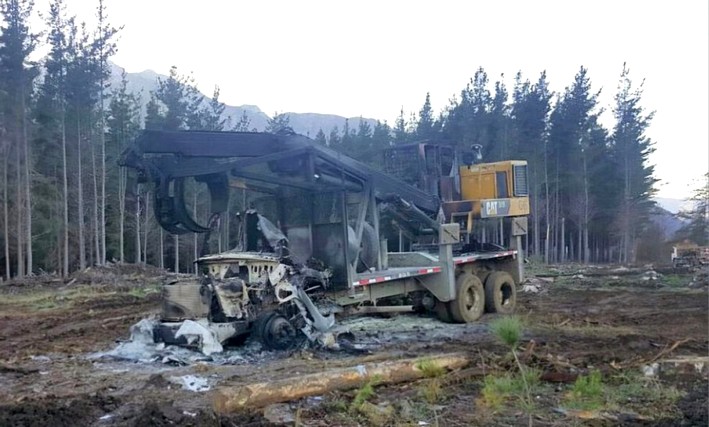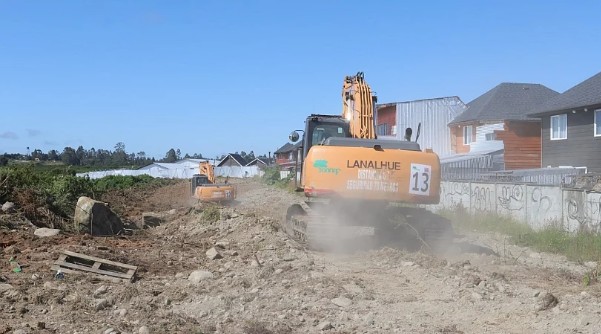The Criminal Prosecution of Intentional Wildfires and Their Potential Link to Subsequent Crimes
The firefighting capacity for these disasters and the significant human and financial resources involved can minimize the damage caused by intentional acts, which paradoxically works against the convictions of those accused of this crime in Chile.
In 2019, a fire in Pidima, La Araucanía Region, began with nearly simultaneous ignition at eight points, all spaced similarly apart—an event far from coincidental. Likewise, the clearly intentional wildfire in early January of this year at the El Rosal property in Lebu, which started with 20 simultaneous ignition points, included a pamphlet against "forestry companies." The tragic February fires, which claimed 26 lives, left over 5,000 victims and nearly 300,000 hectares affected, with 28 people detained for potential responsibility.
According to public statements from CONAF, in 2021, 50% of wildfires were intentional, and those who start them understand fire behavior. Yet, despite the evidence, few are convicted for this crime, which carries penalties of up to 20 years in prison depending on severity—whether due to negligent or intentional action—and fines of up to $12 million for those causing these emergencies, which have worsened due to climate change and drought.
The strong firefighting and response capabilities developed by CONAF teams, forestry companies, firefighters, Carabineros, and the military, along with major investments in recent years, have ensured that most of these fires can be controlled—albeit at a high cost.
But what happens to those responsible for these disasters, whether due to negligence or intent? What does Chilean law stipulate? How is criminal prosecution pursued?
Renato Fuentealba, Director of Criminal Affairs at Arauco, explains that Chile has two legal frameworks regulating wildfire intentionality: "The Chilean Penal Code, since its inception, penalizes under Article 474 and following the crime of arson against property, punishing the immense destructive capacity of fire with severe penalties."
The Penal Code addresses this, but intentional arson is also defined in the 1931 Forest Law by the Ministry of Lands and Colonization, which penalizes reckless fire-starting—unlike the Penal Code. "Here, it distinguishes between intentional crimes and quasi-crimes (negligence). The Penal Code only punishes those who deliberately cause harm through fire, while the Forest Law holds accountable those who act recklessly, failing to take precautions. But today, the greater societal impact comes from those who intentionally start fires to cause harm," the lawyer notes.
Fuentealba argues the problem lies in defining intentional arson. It’s not just lighting a fire—using a lighter or grilling does that—but the fire’s uncontrollability makes the difference. "Legal doctrine states arson occurs when fire becomes uncontrolled—a matter of scale, force, and power." He cites a case: "Years ago, I saw an intentional fire in an ARAUCO forest. The suspect left clear evidence of intent, yet their defense argued the five-year sentence was excessive since the fire caused no damage due to forestry companies' control efforts. No judge hesitates to punish someone who burns houses—10 years in prison is certain. But what if only 10 m² burned?"
When assessing intent, the crime ties to property damage, but trials overlook the danger of the act itself and the perpetrator’s harm potential. Convictions hinge on firefighting efficiency: "Low conviction rates aren’t due to weak laws but judicial focus on damage over danger. Arauco Province has Chile’s highest wildfire rates, yet large-scale fires like Valparaíso’s are rare because forestry companies react within minutes—the state alone can’t cope. Their efforts are monumental."
When asked about wildfire reports, suspects, and convictions (2019–2022), the Prosecutor’s Office revealed systemic inefficacy: 2,338 reports led to 50 suspects, with only 4 convictions (0.17%).
"Wildfires often occur in unpopulated areas with no witnesses or evidence, making perpetrator identification hard. Even with suspects, lack of qualified personnel hinders on-site forensics. Carabineros’ Labocar and firefighters investigate; CONAF plays no major role despite its mandate. Prosecutors rely on police reports but don’t investigate firsthand."
On whether forestry companies’ surveillance tech aids prosecutions, Fuentealba states: "This is a public safety issue. The government lacks focus on prevention. We know high-risk zones, and intentional fires there often lead to later crimes like land usurpation and timber theft—these are linked. Burned areas are often illegally occupied the next year. There’s no will to probe root causes or look beyond who lit the fire. Most arson ties to other crimes, but prosecutors ignore this intent."
29 people were arrested for recent wildfires.
The Maule Regional Prosecutor’s Office reported detaining a Haitian national on February 3 after witnesses caught them starting a roadside fire. They were arraigned in Parral’s Guarantee Court and remanded.
In Ñuble, two were arrested under the Forest Law in Bulnes and San Gregorio. One violated Article 22 ter (reckless fire-starting causing damage), receiving biweekly police check-ins and travel restrictions. The other breached Article 18 (unauthorized slash-and-burn).
The Biobío Prosecutor’s Office charged 5 suspects. In Arauco, one faced completed arson (Article 22 ter), with travel restrictions and biweekly check-ins, facing possible medium-term prison and fines (11–50 UTM).
In Cañete, another Article 22 ter violator received nighttime house arrest, travel bans, and monthly check-ins, with similar penalties.
In Los Ángeles, three were charged under Penal Code Article 481 (possessing incendiary devices). They were barred from Curamávida Hill—where arrested—and face medium-term prison.
In La Araucanía, four were detained for arson, carrying incendiary devices, and death threats across Carahue, Collipulli, and Angol.
In Los Ríos, one was arraigned on February 6 for trash-burning that ignited a 250 m² fire in Río Bueno, receiving monthly check-ins and travel bans. In Panguipulli, a man lighting a wasp-deterrent fire was arrested. In Lago Ranco, Selma Reinoso burned an old vest, causing a 5,000 m² grass fire but faced no restrictions. Valdivia is investigating a woman for igniting her field.
Of those investigated, two are in pretrial detention, one awaits arraignment, and the rest are under varying restrictions.

















